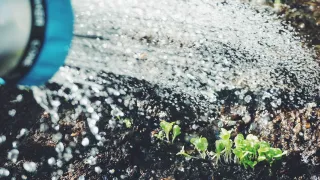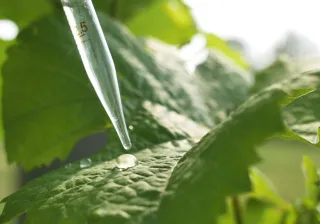Lignocellulose can be used for making surface-sensitive materials, whose reactions with the environment are controlled by water.
- This is also how plants function, says Tekla Tammelin, Research Professor and head of the FinnCERES project at VTT.
FinnCERES is a flagship project, funded by the Academy of Finland, where new materials for the bioeconomy are being developed in a cooperation between VTT and Aalto University.
Our starting point is fundamental research, but the idea is to quickly implement the results in applications. The FinnCERES ecosystem offers a direct communication channel to industry.
VTT and Aalto University have a long history of research cooperation. The flagship aims to form an entire ecosystem to advance economic growth by developing new business opportunities. This would not be possible without the national bioeconomy infrastructure in Otaniemi, Espoo.
- We have not had these kinds of flagship programmes in Finland before. In addition to conducting research, we will involve businesses and other financing opportunities. Internationalisation is also an important aspect to ensure the success of the flagship, which is important for the Finnish national economy, Tammelin explains.
Tammelin was appointed Research Professor in Biomaterials Engineering and Design at VTT and head of the FinnCERES project at the beginning of December 2018. At Aalto University, the project is headed by Professor Orlando Rojas from the School of Chemical Engineering.
Plant functionality into materials
The components of plant materials, namely lignocellulose, are cellulose, lignin and hemicellulose. The main component – cellulose – is hygroscopic and hydrophilic, which means that cellulose absorbs and retains water. This is why the water interactions of lignocellulose play a key role in many of the ongoing research projects in FinnCERES. This property, often considered a disadvantage, can be turned into an advantage.
- Paper loses its strength characteristics when placed in water. Therefore, most of the research in the field has been focused on eliminating the effect of water. However, water is practically a structural element in wood, and holds herbaceous plants upright,"says Eero Kontturi, Professor of Materials Chemistry of Cellulose at Aalto University.
The association of water to the surface of lignocellulose is studied at the molecular level and at the nanoscale. According to VTT's Senior Scientist Suvi Arola, the results can also be transferred to the macroscopic scale.
- The association with water is enhanced at nanoscale, making it easier to study the interactions. The same phenomena occur in paper and textile fibres or in any cellulosic material.
Usually, massive instruments like powerful electron microscopes and sensitive X-ray equipment are needed to reveal tiny structures.
- We're taking the reverse approach. By covering a cellulose molecule with a layer of water and examining how many water molecules it can absorb, we can make fundamental conclusions about the structure and dimensions of cellulose, explains Kontturi.
At the same time, it is possible to study how water behaves on the surface of cellulose: Does it act as individual molecules or as a uniform film of moisture? Even moist air produces a surface layer on lignocellulose in which a large part of the overall structure is water. The researchers in FinnCERES are seeking to implement plant functionalities in new biomaterials.
- Actually, all functionalities of plant cell walls are based on interactions with water. By increasing our understanding of these interactions, we can create materials that take advantage of the strong role of water, says Tammelin.
Added value for pulp mill side streams
One of the FinnCERES themes is the development of new technologies to be used in the process industry. Paper is made from wood by removing lignin, which gives wood its brown colour and glues the fibres together. The mainstream technology used for lignin removal, the Kraft process, has already been in place for 150 years. Modern pulp mills are biorefineries where lignin is burned into energy and that utilise the process side streams.
- The molecules of the side streams can be further refined. For example, lignin could be converted into chemicals that could provide added value or be more environmentally efficient, Kontturi describes.
Tammelin says that FinnCERES can contribute to pulp mill processes, for which new methods can be developed to separate the fibre components.
- We can provide more diverse use of the structural components of lignocellulose if they can be separated more cleanly and efficiently.
Bleached pulp is the most important raw material that can be refined into nanocellulose. Nanocellulose can, in turn, be used to produce transparent materials, and even composites when combined with other materials. In this regard, cellulose has the potential to replace plastics.
- Nanocellulose has properties that are needed in water purification: plenty of active surface and adsorption capacity. Removal of microplastics from water could be one potential application area, remarks Arola.
The flagship has ambitious goals.
- Our goal is to find material properties in lignocellulose that have not been utilised or even known before, Tammelin sums up.
New research initiatives every year
In the spring of 2018, FinnCERES received EUR 9.5 million in funding from the Academy of Finland for the first four years, after which funding for another four-year period will be decided. The research programme will be updated as the project progresses.
- There will be a call for new research initiatives every year, ensuring the continuous renewal of the programme, says Tammelin.
At the moment, 13 research projects are underway, including some 80 researchers. In addition to the research projects, the FinnCERES community is building the FinnCERES ecosystem that companies can join.
- We are building an ecosystem on top of the flagship, and it may include research programmes other than those funded by the Academy of Finland.
The Academy of Finland has also selected five other flagships into its flagship programme. In addition to FinnCERES, VTT and Aalto University are also involved in the Finnish Center for Artificial Intelligence and the Photonics Research and Innovation flagships. The other three flagships are 6Genesis, the 6G-Enabled Wireless Smart Society and Ecosystem; the Digital Precision Cancer Medicine Platform; and the Inequalities, Interventions, and New Welfare State flagship.






